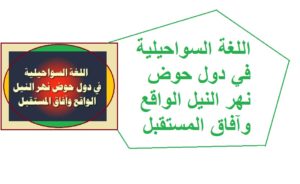اللغة السواحيلية في دول حوض نهر النيل الواقع وآفاق المستقبل
تُعد اللغة السواحيلية إحدى أهم اللغات الإفريقية وأوسعها انتشاراً على الإطلاق، حيث تغطي إقليماً جغرافياً مترامي الأطراف يمتد من جنوب الصومال مرورًا بكينيا وتنزانيا وأوغندا وموزمبيق ورواندا وبوروندي وزامبيا وملاوي والكنغو الديمقراطية وصولاً إلى مدغشقر وجزر القمر. وتُصنف اللغة السواحيلية ضمن مجموعة لغات البانتو المنبثقة عن أسرة اللغات النيجركنجوية من فصيلة اللغات النيجركردفانية إحدى أكبر الفصائل اللغوية الخمس الكبري في إفريقيا. ويُقدر عدد المتحدثين بالسواحيلية ما بين خمسين إلى سبعين مليون نسمة كلغة أولى، ونحو ثمانين إلى تسعين مليون نسمة كلغة ثانية أو لغة تفاهم مشترك، في حين تذهب بعض التقديرات إلى أن عدد متحدثي السواحيلية كلغة أولى أو ثانية أو لغة تعامل مشترك يصل إلى نحو 160 مليون نسمة.

تُستعمل اللغة السواحيلية كلغة رسمية فى تنزانيا الاتحادية، وهى أيضاً اللغة الرسمية الثانية بعد اللغة الإنجليزية فى كينيا, واللغة الوطنية ولغة التعاملات التجارية فى أوغندا، ولغة تفاهم وتعامل مشترك فى سائر دول الإقليم الشرقي لأفريقيا. وتحتل السواحيلية المرتبة الثانية بعد اللغة العربية المنتشرة في شمال القارة الإفريقية تليها لغة الهوسا المنتشرة في الإقليم الغربي من القارة الإفريقية.
ولما كانت اللغة السواحيلية تحظى بحضور وانتشار واسعين في دول حوض نهر النيل؛ حيث نجدها حاضرة بقوة في ست دول من أصل إحدى عشرة دولة هى دول حوض النهر هى: تنزانيا، وكينيا، وأوغندا، وجمهورية الكونغو، الديمقراطية، ورواندا، وبوروندي. وتتفاوت درجة حضور السواحيلية سواء من حيث الانتشار أو الاستخدام من دولة لأخرى من تلك الدول الست، ففي الوقت الذي تُسجل فيه أعلى درجات حضور السواحيلية في دولة تنزانيا الاتحادية، تُسجل أدنى درجات الحضور في دولة بوروندي.
وعليه تأتي هذه الورقة البحثية لإلقاء الضوء على وضع اللغة السواحيلية في دول حوض نهر النيل، وأهميتها والدور الذي تؤديه في التواصل والتلاقح الثقافي بين دول حوض نهر النيل قاطبة، وذلك من خلال المحاور الثلاثة الآتية:
المحور الأول: وضع اللغة السواحيلية وأهميتها في دول حوض نهر النيل.
المحور الثاني: التحديات التي تواجه اللغة السواحيلية .
المحور الثالث: رؤية استشرافية لمستقبل اللغة السواحيلية في دول حوض نهر النيل.
د. سيد رشاد 1
1د. سيد رشاد قرني محمد: مدرس الدراسات اللغوية واللغة السواحيلية– معهد البحوث والدراسات الإفريقية– جامعة القاهرة – مصر.
الوضع اللغوي في جمهورية تنزاينا الاتحادية
The Swahili language in the Nile River Basin countries: reality and future prospects
Swahili is one of Africa’s most widely spoken languages, covering a vast geographic region stretching from southern Somalia to Kenya, Tanzania, Uganda, Mozambique, Rwanda, Burundi, Zambia, Malawi and Democratic Republic of Congo to Madagascar and Comoros. Swahili is classified as a Bantu language group of the Nigerkengawi language family of the Nigerkerkerdovanian language family, one of the five largest language families in Africa. The number of Swahili speakers is estimated at between fifty and seventy million as a first language, and about eighty to ninety million as a second or common language of understanding, while some estimates put the number of Swahili speakers as a first, second or common language of interaction to about 160 million.
Swahili is an official language in the Federal Republic of Tanzania, and is also the second official language after English in Kenya, the national language and the language of business dealings in Uganda, and the language of understanding and interaction in the rest of the Eastern African Region. Swahili is second only to Arabic, which is widespread in northern Africa, followed by Hausa, which is spoken in the western region of the African continent.
Since the Swahili language enjoys a wide presence and spread in the Nile River Basin countries, where we find it strongly present in six out of eleven countries: Tanzania, Kenya, Uganda, the Democratic Republic of the Congo, Rwanda, and Burundi. The degree of Swahili presence varies in terms of prevalence and usage from one country to another of these six countries, with the highest Swahili presence in the Federal State of Tanzania, the lowest in Burundi.

Accordingly, this research paper sheds light on the status of the Swahili language in the Nile River Basin countries, its importance and the role it plays in communication and cultural cross-fertilization between the Nile Basin countries as a whole, through the following three axes:
The first axis: the status of the Swahili language and its importance in the Nile River Basin countries.
The second axis: the challenges facing the Swahili language.
The third axis: a forward-looking vision for the future of the Swahili language in the Nile River Basin countries.